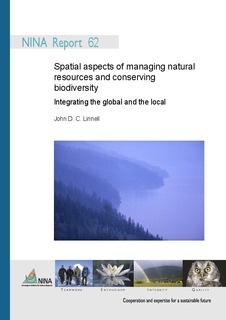Spatial aspects of managing natural resources and conserving biodiversity. Integrating the global and the local
Research report

Åpne
Permanent lenke
http://hdl.handle.net/11250/2448000Utgivelsesdato
2005Metadata
Vis full innførselSamlinger
- NINA Rapport/NINA Report [2341]
- Publikasjoner fra CRIStin - NINA [2364]
Sammendrag
Linnell, J. D. C. 2005. Spatial aspects of managing natural resources and conserving biodiversity.
Integrating the global and the local - NINA Report 62. 38 pp.
The issue of scale has recently attracted much importance in ecology. It is also of crucial importance in the context of managing nature. The question that constantly appears is ·at what level should we manage our natural resources?" From the point of view of the social sciences, there is a trend to move resource management to the local level, to satisfy objectives such as the desire for social equity, social justice and local empowerment. However, from the point of view of ecology, the recent development of ecosystem thinking calls for management to be moved up to larger spatial scales such that holism can be maintained. This apparent contradiction of the "local ecosystem" is actually imbedded in the Convention on Biological Diversity's Malawi principles. Finding ways to include both the local and the global is clearly a key need for improving natural resource management.
The first part of the report presents some concrete analyses where the importance of scale issues for Norwegian natural resource management is highlighted. The examples include (1) an analysis of the various spatial scales at which ecological processes operate, (2) using data on movement of radiocollared lynx to improve national level monitoring, (3) using data on wolf dispersal and Baltic sea ice conditions to explore the potential for wolves having re-colonised Scandinavia from Finland on their own, (4) drawing up principles for the spatial aspects of planning large carnivore recovery in Norway that combine both
ecological. administrative and social aspects. and (5) a set of analyses to see to what extent scale varies within and between species, and the identification of ways of predicting scale. The main message from this section is that all scales need to be considered. At least when it comes to large carnivores, where each individual uses several municipalities, "local" management must be considered on scale of 10s or 100s of square kilometres.
The second part of the report is a review of the scientific literature dealing with the issues of scale and resource management from the viewpoints of many different disciplines. We firstly look at the experience with community based conservation. various decentralization or devolution projects, and co-management systems especially those that nave Men conducted in tropical countries and the arctic. The experiences from these attempts to pass greater resource management responsibility to the local level are mixed. Many of those from tropical countries are negative, with the comanagement tradition from the arctic offering the most optimistic outcomes. Problems with lack of capacity, elite capture, and corruption often led to a decline in the sustainability of resource use. and often a decrease in equity as well. Secondly, we examined the literature dealing with democracy and environmental justice. which provided many insights into the issue of scale, NIMBYism (Not In My Back Yard) and decision making within the context of public goods and local costs. Again, the experience at the local level is poor. especially when the costs and benefits of resource conservation are felt at different scales. Thirdly we look at some of the characteristics of different resources in light of how suitable they might be for more local - or less local - level management. and develop some guiding principles.
Finally, we attempted to gather these various inputs together and come up with a conceptual framework for future thinking. It is apparent that resource management cannot be conducted at a single scale - be it local or national or global or someplace in between. There is a need to consider all scales - with different decisions being appropriate for different scales. Management should be viewed as a nested hierarchy, where upper levels set general frameworKs of guidelines and principles, and the lower levels make increasingly detailed, and locally adapted, decisions. within the framework set by the upper levels. This approach shOuld in principle allow "freedom within limits", and follows the principle of subsidarity. The challenge for the future is to ensure the effective coordination of management at multiple scales and to ensure democratic representation of the lower (local) levels in the upper level decision making processes.